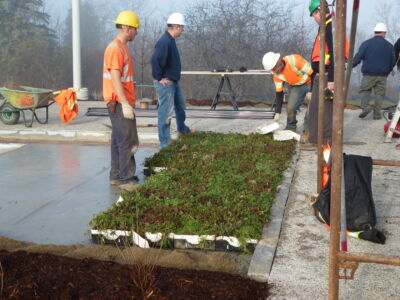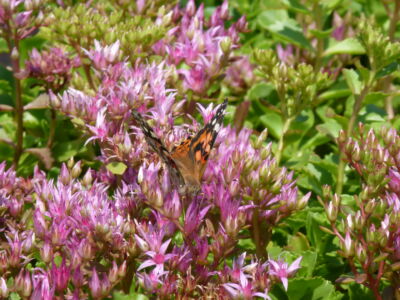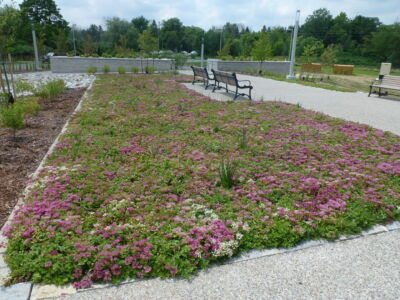The WCC Live Roof – 12 Years Growing!
When the Upper Thames River Conservation Authority (UTRCA)’s Watershed Conservation Centre was built in 2012, a 75 m2 live roof garden was installed on either side of the sidewalk leading up to the front doors. The live roof sits on top of part of the basement of the old office building, which was retained and renovated into a storage room.

The live roof is one component of the Leadership in Energy and Environmental Design (LEED) designation that the building received. LEED is a green building certification program used worldwide. One of the requirements to achieve LEED designation is to limit the area of paved surfaces that contribute to runoff and the urban heat island effect. Live roofs are designed to absorb and retain rainwater for several hours, thus reducing peak runoff by as much as 30-50%. The green plants absorb the heat and provide cooler, moister air to the nearby concrete environment.
The roof was installed in modules by Live Roof Systems out of Mt. Brydges. The modules contain about 3 inches (8 cm) of engineered growing medium (crushed stone), which supports a mix of low sedums and chives. The plants are selected for their ability to grow in these unique conditions. The sedums are drought tolerant, so do not need watering except in extreme droughts. During the summer flowering season, the flowers attract pollinators, especially bees.

Maintaining a live roof is not difficult, but it does require some effort and trouble shooting. Soil tests are carried out every other year and a low phosphorus fertilizer is added as needed. Ongoing weeding is important to keep the sedums and chives the dominant plants.
One surprising problem we encountered was salt dieback from the use of de-icing on the sidewalk next to the Live Roof (not a problem in installations on the top of buildings). Now, staff shovels and salts only a narrow strip of the sidewalk, leaving the snow to block as much of the salty runoff as possible from reaching the Live Roof. Calcium sulphate (limestone) is added to help leach the salt.
From time to time, plant dieback is noticed in various spots. This is remedied by clipping the top 1-2 inches of healthy sedum plants, and laying the clippings on the bare soil. They root where they hit the ground and continue growing and spreading.

The life expectancy of the live roof soil medium is 60-70 years. Thus far, the UTRCA is pleased with the performance and beauty of its live roof. Long live the live roof!
Contact: Cathy Quinlan, Terrestrial Biologist

